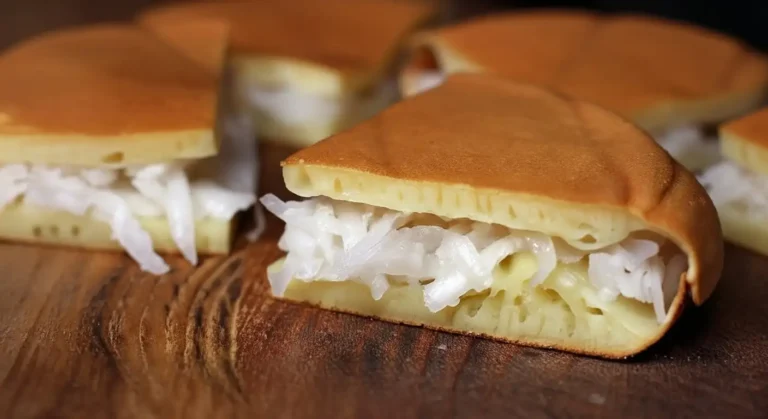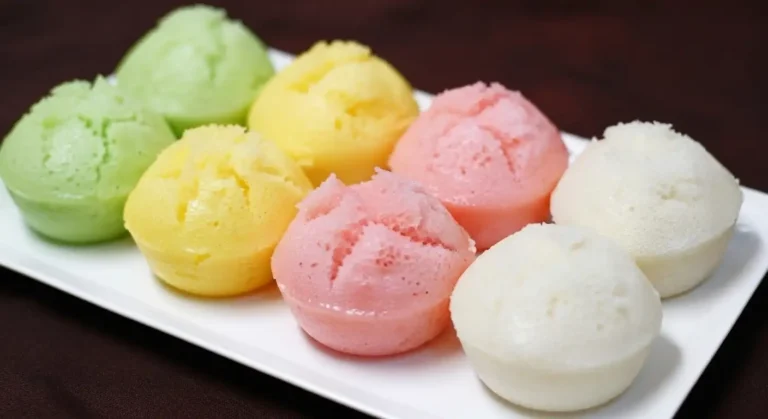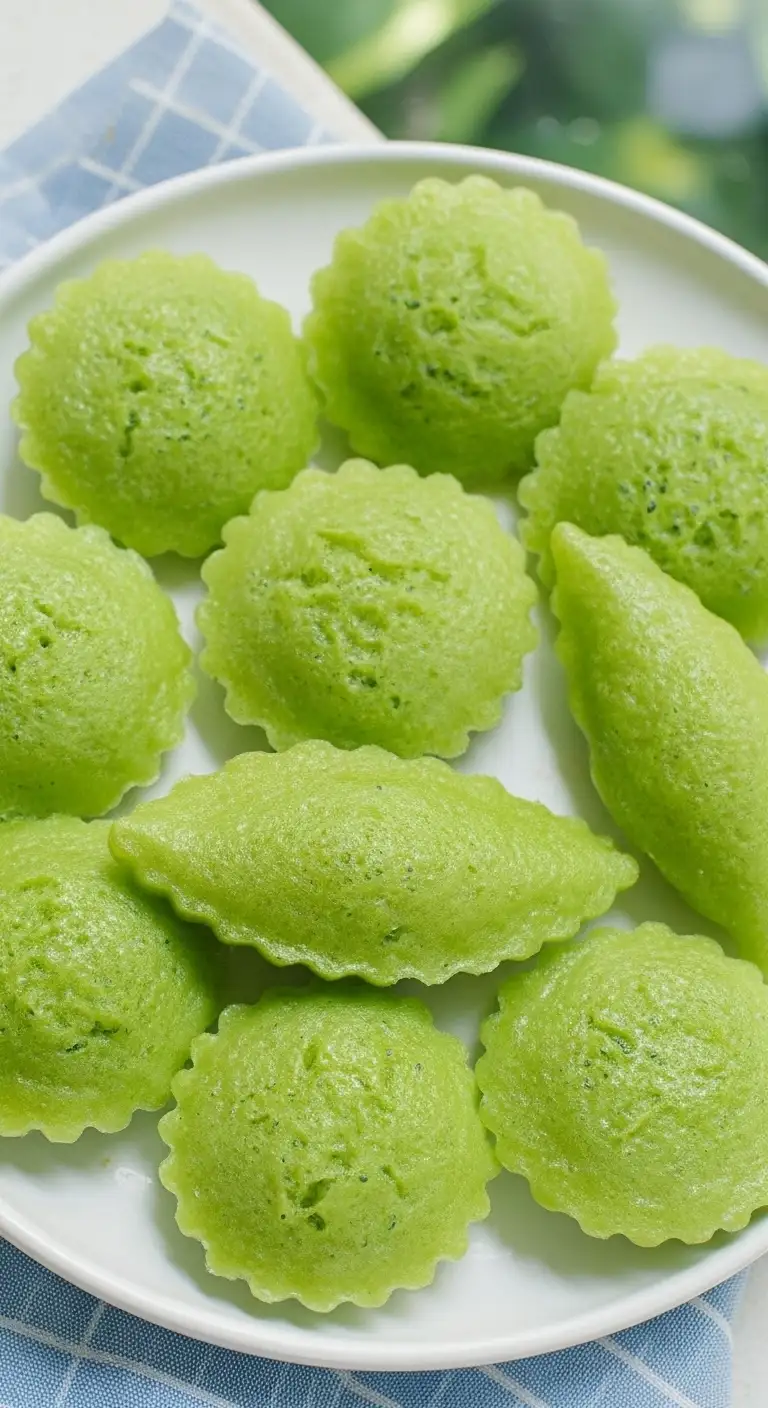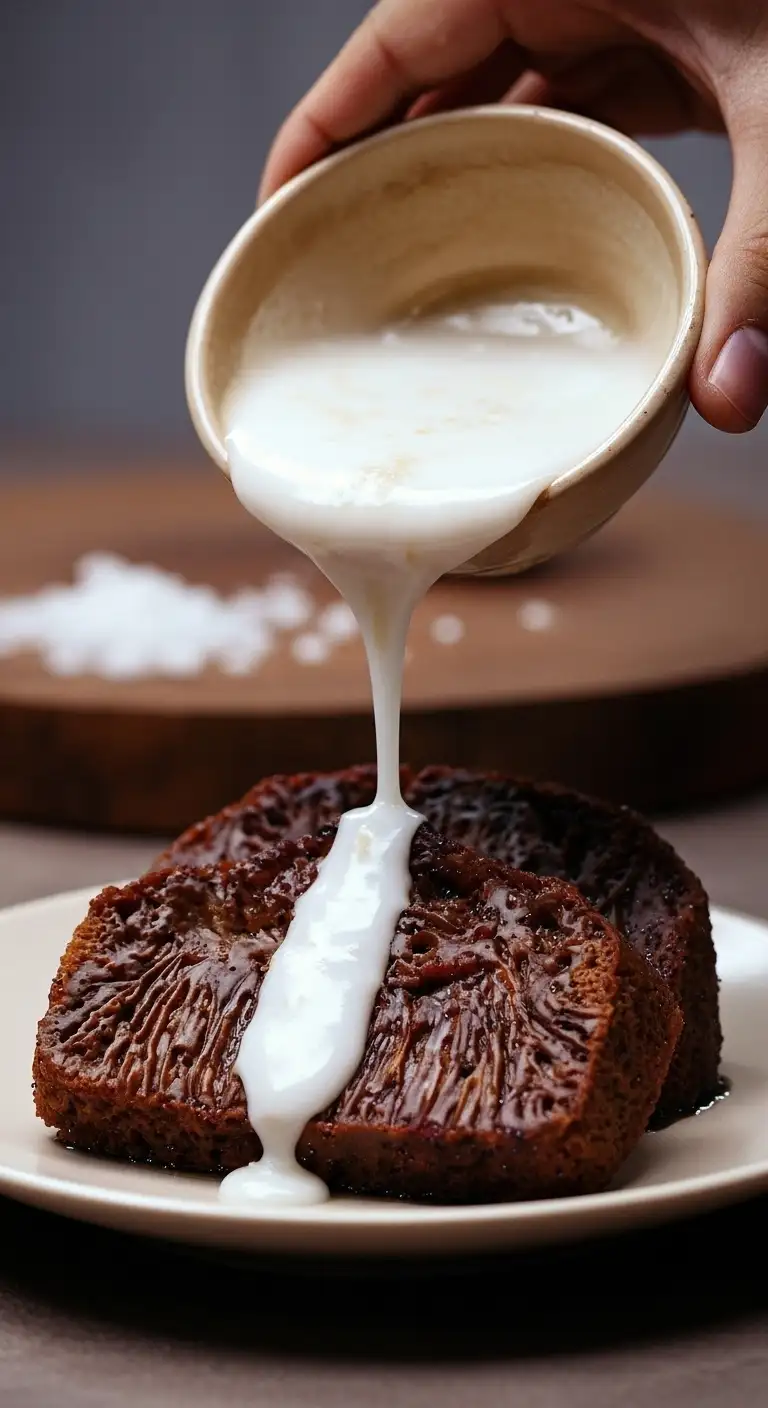Bánh Bò (pronounced bahn baw), often translated as “Cow Cake” or, more accurately, the “Honeycomb Cake,” is a quintessential Vietnamese dessert. This delightfully light, spongy, and chewy cake is celebrated for its distinctive airy texture and aromatic coconut-pandan flavor.

The Basics of Bánh Bò
What is it?
Bánh Bò is a sweet, Vietnamese sponge cake known for its signature “honeycomb” or “beehive” interior—a web of interconnected air pockets formed during the cooking process.
The Name:
The literal translation of Bánh Bò is “Cow Cake,” but this is debated. Most commonly accepted explanations relate to the verb bò, which means “to crawl” or “to rise.” As the yeast-leavened batter proofs, it slowly “crawls” up the side of the bowl, inspiring the name.
Key Ingredients:
Rice Flour & Tapioca Starch: Provides the base and gives the cake its springy, slightly chewy texture.
Yeast: Essential for the fermentation and proofing process, which creates the interior’s airy, spongy structure.
Coconut Milk: Adds richness, moisture, and the cake’s characteristic sweet, creamy flavor.
Sugar: Sweetens the cake, often white sugar or palm sugar.
Pandan: The most popular flavoring, giving the cake a vibrant green color and a sweet, vanilla-like aroma.
Texture and Flavor:
A well-made Bánh Bò should be light, fluffy, and incredibly springy on the outside, with a unique chewy and slightly sticky interior texture. The flavor is a harmonious blend of sweet coconut and fragrant pandan.
Types of Bánh Bò (Cooking Methods & Flavors)
The main variations of Bánh Bò are determined by the cooking method and the flavoring used.
| Vietnamese Name | Cooking Method | Key Characteristics |
|---|---|---|
| Bánh Bò Nướng | Baked (Nướng means "baked") | The most popular version outside of Vietnam. Baked in a large ring or loaf pan, resulting in a golden-brown, slightly crispy crust and a soft, chewy interior with the best honeycomb structure. Often sliced into wedges. |
| Bánh Bò Hấp | Steamed (Hấp means "steamed") | Typically made in small, individual, colorful cupcake-sized molds. It has a softer, chewier, and denser texture than the baked version and no brown crust. It is often served with a sweet coconut sauce. |
| Bánh Bò Thốt Nốt | (Palm Sugar) | Can be steamed or baked. Made using palm sugar (thốt nốt), which gives the cake a distinct natural golden-yellow color and a deeper, more mellow, caramel-like sweetness. |
| Bánh Bò Sữa | (Milk/Modern) | A newer variation where traditional coconut milk is partially or entirely replaced with regular dairy milk, giving it a slightly different flavor profile. |

How to Enjoy Bánh Bò
Bánh Bò is enjoyed as a sweet snack or dessert, often consumed at room temperature or slightly warm.
On Its Own: The cake is flavorful enough to be eaten by itself, making it a perfect light snack for afternoon tea or coffee.
With Coconut Sauce: The steamed varieties (Bánh Bò Hấp), especially the small colorful ones, are typically drizzled with a thick, sweet coconut sauce (nước cốt dừa) and often garnished with toasted sesame seeds and chopped peanuts.
The Savory Twist (Southern Style): In some Southern regions, the small steamed cakes are sometimes used in a savory preparation, such as being sandwiched inside a Bánh Tiêu (a fried, hollow donut), or served with savory fillings.
Tearing vs. Biting: To fully appreciate the unique, chewy texture and the honeycomb pattern, many locals recommend tearing the cake into small, bite-sized pieces rather than biting directly into a large slice.
Regional Differences in Bánh Bò
Bánh Bò is generally considered a Southern Vietnamese specialty that has spread throughout the country. While widely available, the preparation and serving style vary.
| Region | Emphasis & Style | Key Differences |
|---|---|---|
| Southern Vietnam (HCMC, Mekong Delta) | The Origin. Bánh Bò originated in the South and remains most popular here. It is prepared with the richest amount of coconut milk, giving it a sweeter, creamier, and highly fragrant profile. Both the baked (Nướng) and steamed (Hấp) varieties are common. | Bánh Bò Thốt Nốt (Palm Sugar) is particularly associated with the South (e.g., An Giang province). Savory preparation (served with Bánh Tiêu) is a Southern trend. |
| Central Vietnam (Hue, Da Nang) | Widely Available. The cake is common in Central markets, especially the brightly colored steamed versions. Central cuisine is known for its balance and sometimes a preference for a slightly less intense sweetness than the South, though the Bánh Bò recipe is largely Southern. | The cake often maintains the classic Pandan flavor and is typically sold in the individual, colorful Steamed form. |
| Northern Vietnam (Hanoi) | Less Common. Bánh Bò is available, but it is less prominent than in the South. While the recipe is the same, the Northern version may be slightly less sweet, reflecting the regional preference for subtler flavors. | The North has a similar traditional steamed rice cake called Bánh Đúc, which is distinct (savory or sweet, but not honeycomb structured), making Bánh Bò a notable import from the South. |




